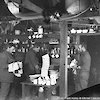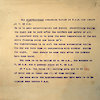Busy, busy, busy
Frank Hurley was a naturally active man with a creative spirit and an insatiable curiosity. He rose to the challenge of recording on film the life of the AAE, seeking to capture not just the drama of outdoor events but also the intimacy of life indoors. His Cape Denison work was to establish his reputation, later cemented as a member of Shackleton’s ill-fated Endurance expedition, as a pre-eminent photographer of the Antarctic.
For Hurley, the work was often difficult but always fun:
No conditions could have been more unsuited for photography. I was determined however, to make the blizzard itself a subject for a moving picture. To illustrate the pace and force of the wind I built a shelter from blocks of ice and under its lee photographed the meteorologists as they fought their way to and from the recording instruments … Frequently my fingers, which I had to withdraw from the mitt to turn the handle of the cinema camera, were frostbitten, and often, in moving from point to point, I was swept away by fierce gusts.
There was no shortage of technical wizards among these young men. Besides Hurley, there was Percy Correll, who repaired instruments damaged by accident or climate. Bage, too, was no slouch in such tasks, ensuring his timepieces kept working in the most adverse circumstances. And then there was Frank Bickerton.
Bickerton’s main winter-time job was to get the ‘air tractor’ up and running, transforming the wrecked monoplane into a sledge-towing ‘air tractor’. The finished machine was taken out of its hangar and anchored on the ice surface, but the unrelenting wind made testing very difficult. He recorded that in the windy, freezing conditions of a Cape Denison spring the engine oil was too thick for effective operation:
It was not until November 15 that the engine worked outside, and, being calm and sunny, it needed no more stimulant or energy that it would in a decent climate.
There were the dogs to attend to — the job of Xavier Mertz and his good friend Belgrave Ninnis. Herbert Murphy, who was responsible for stores, had a role for the dogs besides pulling sledges (which they began doing in July) — he sometimes called on them to fetch frozen meat out from under the hut. As Mawson commented dryly, this often resulted in a chase over rock and ice — not always successful.
Besides cooking, the men took turns to serve as ‘messman’, whose duty was to sweep out the hut, melt ice for cooking, help wash up and generally do all the dirty work. The night watchman was another shared task, as Laseron recorded:
Owing to possible danger from fire, it was necessary that someone should be awake all the time. Then the stove had to be stoked, meteorological observations taken and records kept. This turn of duty gave the opportunity, if so desired, to wash out a pair of socks or two, or even to have a bath in the small folding canvas bath provided for the occasion.
Finally, the men needed to prepare for the springtime sledging program: modifying sledges, sewing food bags, stitching harnesses, filling food bags with carefully weighed rations, and repairing clothing, tents and other equipment, among many other tasks.



